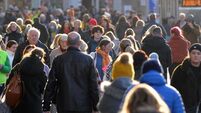People with long-standing health problems at greater risk of poverty than those with no health issues

The Central Statistics Office has said poverty rates and rates of enforced deprivation are higher for people with poorer health across a range of indicators.
Poverty rates are almost four times higher among people with long-standing health problems than those not limited by a health issue, new figures have shown.
The Central Statistics Office (CSO) has said poverty rates and rates of enforced deprivation are higher for people with poorer health across a range of indicators.
Last year, 15.3% of households which included at least one person who was severely limited in usual activities because of a health problem said they failed to pay a utility bill in the last year due to financial difficulties.
This was three times the rate compared to households where no one was described as “activity limited”.
A household is considered to be living in enforced deprivation when they meet two of 11 distinct criteria, such as an inability to afford two pairs of shoes, an inability to afford new clothes, an inability to afford an afternoon or evening out in the last fortnight or being without heating at some stage in the last year.
Meanwhile, a household is deemed to be at risk of poverty when a person earns below 60% of the national median income.
Someone is then deemed to be living in “consistent poverty” when they are both at risk of poverty and living in enforced deprivation.
Households were also asked the extent to which housing costs such as rent, mortgage, home insurance, utility bills and other costs were a burden.
Statistician Paul Christopher said: “Four in 10 (40.9%) households with a severely limited household member considered housing costs a heavy burden. This was significantly higher than the rate for households where all household members were not limited (27.1%).”
This research from the CSO also looked at the range of one-off cost-of-living measures introduced by the Government in 2022 to help support families hit by rampant inflation. This included payments for those in receipt of child benefit, disability allowance, the fuel allowance and the carer’s support grant.
Although welcomed by charities as providing support when people needed it most, they have consistently called for more sustainable measures to support families at risk of poverty in Ireland. Ahead of the next budget, calls for such measures are being repeated.
The CSO found 19.7% of people who perceived their general health as “very bad” were at risk of poverty in 2023 when including these cost-of-living supports. However, without the one-off measures, this would have risen to 27.1%.
It determined these payments had a greater impact on those with a limiting health condition than those without one.
“Analysis of the impact of the cost-of-living measures on reducing the at risk of poverty rates by age group showed that the largest impact was for people aged 65 years and older,” the CSO said, adding the results of the last Census showed the proportion of people reporting very good health decreases with age.
“It is therefore, perhaps, not surprising that the impact of the cost-of-living measures in reducing poverty












